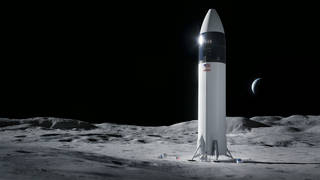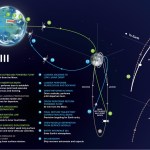Artemis III
Artemis III will build on the crewed Artemis II flight test, adding new capabilities with the human landing system and advanced spacesuits to send the first humans to explore the lunar South Pole region.

Mission Overview
Artemis III
Humanity's return to the lunar surface
Over the course of about 30 days, the Artemis III astronauts will travel to lunar orbit, where two crew members will descend to the surface and spend approximately a week near the South Pole of the Moon conducting new science before returning to lunar orbit to join their crew for the journey back to Earth.
Learn More about Artemis III
The Spaceport
The systems and facilities that assemble and launch rockets and spacecraft for NASA’s Artemis missions.
Learn More about The Spaceport
The Launch: SLS Rocket
The crew of four astronauts will launch on the Block 1 configuration of the Space Launch System (SLS) rocket from NASA’s Kennedy Space Center in Florida . SLS is the only rocket capable of launching crew to the Moon aboard Orion.
Learn More about The Launch: SLS Rocket
The Ride: Orion
The crew of Artemis III will ride to lunar orbit aboard the Orion spacecraft, where Orion will dock with the Starship human landing system in preparation for their journey to the lunar surface. Orion is the only spacecraft capable of returning crews to Earth at lunar reentry velocities.
Learn More about The Ride: Orion
The Lander
Two crew members will board the SpaceX Starship Human Landing System in lunar orbit and descend to the surface where they will collect samples, perform science experiments, and observe the lunar environment before returning to orbit aboard the Starship HLS.
Learn More about The Lander
The Suits
The crew members will wear Axiom Space's advanced spacesuit as a one-person spacecraft that will protects them from the extreme environment of space while they are are performing moonwalks on the Artemis III mission.
Learn More about The Suits
Where We're going
Lunar Site Selection
As NASA prepares to send astronauts back to the Moon under Artemis, the agency has identified nine candidate landing regions near the lunar South Pole.
Each region contains multiple potential landing sites for Artemis III, which will be the first of the Artemis missions to bring crew to the lunar surface.
Learn More about Lunar Site Selection
Why We're Going
Science Objectives
Field geology, sample collection and return, and deployed experiments all are part of the necessary mix of work to advance scientific discovery at the Moon.
The Moon often is referred to as the cornerstone of the solar system, and the Artemis III investigations aim to help scientists better understand fundamental planetary processes that operate across the solar system and beyond.
Learn More about Science Objectives



































